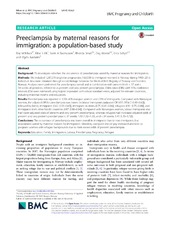| dc.contributor.author | Nilsen, Roy Miodini | en_US |
| dc.contributor.author | Vik, Eline Skirnisdottir | en_US |
| dc.contributor.author | Rasmussen, Svein | en_US |
| dc.contributor.author | Small, Rhonda | en_US |
| dc.contributor.author | Moster, Dag | en_US |
| dc.contributor.author | Schytt, Erica | en_US |
| dc.contributor.author | Aasheim, Vigdis | en_US |
| dc.date.accessioned | 2019-02-20T17:35:14Z | |
| dc.date.available | 2019-02-20T17:35:14Z | |
| dc.date.issued | 2018-10-26 | |
| dc.Published | Nilsen RM, Vik ES, Rasmussen S, Small R, Moster D, Schytt E, Aasheim V. Preeclampsia by maternal reasons for immigration: A population-based study. BMC Pregnancy and Childbirth. 2018;18(1):423 | eng |
| dc.identifier.issn | 1471-2393 | |
| dc.identifier.uri | https://hdl.handle.net/1956/19127 | |
| dc.description.abstract | Background: To investigate whether the occurrence of preeclampsia varied by maternal reasons for immigration. Methods: We included 1,287,270 singleton pregnancies (163,508 to immigrant women) in Norway during 1990–2013. Individual data were obtained through record linkage between the Medical Birth Registry of Norway and Statistics Norway. Analyses were performed for preeclampsia overall and in combination with preterm birth < 37 and < 34 weeks of gestation, referred to as preterm and very preterm preeclampsia. Odds ratios (ORs) with 95% confidence intervals (CIs) were estimated using logistic regression with robust standard errors, adjusted for relevant covariates, including maternal income and education. Results: Preeclampsia was reported in 3.5% of Norwegian women and 2.5% of immigrants. Compared with Norwegian women, the adjusted OR for preeclampsia was lowest in labour immigrants (adjusted OR 0.55 [95% CI 0.49–0.62]), followed by family immigrants (0.62 [0.59–0.65]), immigrant students (0.75 [0.65–0.86]), refugees (0.81 [0.75–0.88]), and immigrants from other Nordic countries (0.87 [0.80–0.94]). Compared with Norwegian women, labour immigrants also had lower adjusted odds of preterm and very preterm preeclampsia, whereas refugees had increased adjusted odds of preterm and very preterm preeclampsia (< 37 weeks: 1.18 [1.02–1.36], and < 34 weeks: 1.41 [1.15–1.72]). Conclusions: The occurrence of preeclampsia was lower overall in immigrants than in non-immigrants, but associations varied by maternal reasons for immigration. Maternity caregivers should pay increased attention to pregnant women with refugee backgrounds due to their excess odds of preterm preeclampsia. | en_US |
| dc.language.iso | eng | eng |
| dc.publisher | BMC | eng |
| dc.rights | Attribution CC BY | eng |
| dc.rights.uri | http://creativecommons.org/licenses/by/4.0/ | eng |
| dc.subject | Education | eng |
| dc.subject | Family | eng |
| dc.subject | Immigration | eng |
| dc.subject | Labour | eng |
| dc.subject | Preeclampsia | eng |
| dc.subject | Pregnancy | eng |
| dc.subject | Refugee | eng |
| dc.title | Preeclampsia by maternal reasons for immigration: A population-based study | en_US |
| dc.type | Peer reviewed | |
| dc.type | Journal article | |
| dc.date.updated | 2018-12-12T11:13:09Z | |
| dc.description.version | publishedVersion | en_US |
| dc.rights.holder | Copyright 2018 The Authors | |
| dc.identifier.doi | https://doi.org/10.1186/s12884-018-2034-4 | |
| dc.identifier.cristin | 1641503 | |
| dc.source.journal | BMC Pregnancy and Childbirth | |

